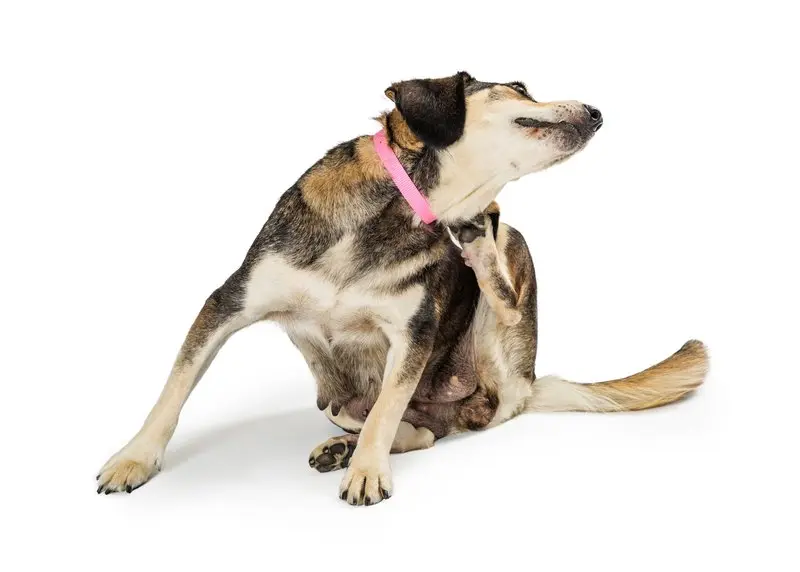With flea season in full throttle now, you may find yourself among the crowd out shopping for products to keep your dog safe. Reading the labels can understandably lead to confusion about which ones are safe to use under which circumstances. In this article, I am going to discuss whether or not flea collars are safe to use on dogs that are pregnant or nursing.
There are a few collars that claim they are safe to use for just about any circumstance. However, most manufacturers have in their product disclaimer that is it not recommended or safe for flea and tick collars to be used by seniors, or bitches that are nursing or pregnant. Most veterinarians will discourage the use of these collars in those circumstances as well.
If you are unsure of whether or not to use any sort of medication or treatment that contains a poison (such as flea collars) on your dog, it is always a good idea to get your veterinarian’s advice first. With that being said, here is the information I found while researching this subject.
Table of Contents
Why are Fleas So Hard to Get Rid Of?
First, let’s take a look at what the big deal is with fleas, and why they are so hard to get rid of. As you may know, fleas are parasites. Typically they are not life-threatening but cause a LOT of discomfort for your dog. Like most parasites, they can lead to numerous amounts of other problems. Some of the issues may include anemia, allergic reactions, or scratching until they have an open wound, resulting in an infection. Also, biting and ingesting infected fleas is the number one cause of tapeworms in dogs. Any of these issues would be cause for concern for a bitch that is nursing or pregnant.
While a single flea or two will typically not be an issue, they can quickly become a severe problem. One adult flea can lay up to 50 eggs per day! That same flea can live anywhere from 1 to 3 months. As you may imagine, one single flea that bites your dog can turn into thousands of fleas within a matter of a few weeks. The chances are that by the time you saw the “first flea,” there were at least dozens by that point. Taking your dog out of the equation by having him stay with friends or family for a weekend won’t stop the infestation around your property at this point, as a flea without a ‘blood-meal‘ can still survive for around 100 days, or may decide you look tasty enough.
Getting rid of fleas quickly and concisely is your best option. There are a lot of chemical options and quite a few natural options available as well. When your dog is pregnant or nursing (and maybe even when they aren’t), you are far better off using natural means as you do not want the poisons and the chemicals harming the mother or her puppies.
Flea Collars on Pregnant or Nursing Dogs

Most people have heard of flea collars, as they have been around for a while now. They were invented in 1964 due to the research an entomologist named Robert Goulding conducted on time-released pesticides. There are two ways in which flea collars typically work, and both are based on those same time-released pesticide studies.
The first way is that the collar will slowly emit a toxic gas designed to either kill the fleas or at least repel them. The second type works by releasing a pesticide into the fatty layers of your dog’s skin in hopes of killing fleas no matter where they bite on the dog’s body. Either method can be harmful or fatal to a pregnant or nursing dog and their puppies.
While not always the case, flea collars can cause reactions or medical conditions in your animal, such as seizures, lethargy, coma, gastrointestinal issues, and cardiac issues. I will cover some better alternatives for you in this article if you have fleas on your dog that is pregnant or nursing.
What Flea Treatment can I use on a Pregnant Dog or Nursing Dog?
Getting rid of fleas can be a significant hassle. If you miss any, they can reproduce quickly, and you will be back to square one. To effectively get rid of them, you have to attack the ones on your pets, in your house, and your yard at the same time. While there are sprays or foggers for your home, you may want to consider alternatives if your dog is pregnant or nursing.
Any treatments containing pesticides should be avoided with a pregnant or nursing dog, or their newborn puppies. With collars, please take a look at their active ingredients, as they can vary quite a bit from brand to brand. If you see amitraz, carbamates, organophosphates, or pyrethrins/pyrethroids, then it’s a no-go, and you will want a different method for protecting your dog from fleas. If you are looking at the natural repellent collars, you may see some with citronella, which is generally considered okay for bitches that are nursing or pregnant.
Cedar can act as a natural repellent for not only fleas but many other types of pests as well, such as mosquitos and ticks. So looking for items with cedar oil in them, may prove a helpful alternative. Many times you can get plant-based flea and tick collars much cheaper than pesticide-based collars. The plant-based collars often combine many natural ingredients, such as cedar oil, citronella, rosemary, peppermint, and lemongrass oil, which are all pest deterrents.
While I cannot say that I personally have tried a plant-based flea and tick collar on any of my dogs, the research I have done on them looks rather promising. At about one-third of the price, or less, of your standard recommended flea collars (and without the potentially harmful side effects), you may want to consider it an option to try out. If you do, let me know in the comments below what your experience was with it! Farther down, I will also give you some great homeopathic methods of getting rid of the fleas around your home and on your pup as well.
What Side Effects Do Flea Collars Have?
As I mentioned earlier, flea collars contain pesticides. Whether it’s from wearing one, or accidentally ingesting part of one, it can have severely detrimental effects on your dog. Pesticides work on bugs by attacking nerve cells and making them fire spontaneously and rapidly. Eventually, the insect will go into spasms and die. While the dosage isn’t high enough to have the same effect on a dog or a human, it would be incorrect to say that they do not have any effect.
The truth is that flea collars that contain pesticides are toxic for dogs and humans as well. I mentioned above that you should look for certain chemicals in the collars, such as:
- amitraz
- carbamates
- organophosphates
- pyrethrins/pyrethroids
However, there are other ones to watch out for as well. Seresto collars are one of the most popular flea collars on the market. While more pricey than some other collars, they typically seem to work the best as far as brands containing pesticides are concerned. The active ingredients for Seresto collars are Flumethrin 4.5% and Imidacloprid 10.0%. While some dogs may not have an issue with them, other pet owners have claimed their dogs had significant reactions, sometimes even fatal. I would not recommend the Seresto collar, or any collar containing pesticides to dogs that are pregnant or nursing.
If your dog has any reaction to the flea collar, you should immediately remove it, and depending on the severity of the reaction, call your vet as soon as possible. Some of those signs may be reactions in their central nervous system. These may include appearing as though your dog looks drunk, is being lethargic, has dilated pupils, having seizures or a coma.
Possible side effects messing with their gastrointestinal system may include vomiting, excessive drooling, diarrhea, and bloating. Other issues could also be a lower heart rate and high or low blood pressure. Skin irritations, rashes, and swelling are also possible side effects.
If your dog somehow ingests part of the collar or licks the collar on another dog, it can increase the chances of these adverse side effects, and I recommend you call your vet as soon as possible. The side effects above are why you would not want to put a flea collar on a dog that is nursing or pregnant, as well as any newborn puppies.
Natural Options to Get Rid of or Prevent Fleas

For starters, you should wash your dog’s bed regularly. Depending on the type you have, you may notice that they come lined with cedar chips inside them. Cedar can be used as a repellent for mosquitos and fleas alike, although they do have a shelf life as far as the duration they will actively work. Around your yard, you can certainly add cedar chips to flower beds or any areas that your dog likes lying around or playing in the yard (also where they frequently go to the potty!)
To be more thorough in killing the fleas in your yard, there is a natural solution you can try that will kill and repel fleas, ticks, mosquitoes, and ants. A company named Cedarcide has two choices they recommend for getting rid of fleas outdoors. Yardsafe is their version that comes pre-mixed, and PCO Choice is the same thing, but a concentrate that will last you longer and let you give your yard more applications. They have more products that are all-natural as well, for your dog and your house, but I have not tried any of them yet.
In the house, you can put down diatomaceous earth on any carpets and rugs. Be sure when you do so that you do not shake it around and breathe it in. If you go with diatomaceous earth, MAKE SURE TO GET THE FOOD GRADE VERSION! They are roughly the same price, and the food-grade version contains less crystalline silica, which isn’t anywhere near as harmful as the filter-grade type that is higher in crystalline silica.
The other difference is that the food-grade version is sterilized and doesn’t contain bacteria that the non-food-grade version might.
Safe Homeopathic Method For Getting Rid of Fleas
While the methods I listed in the paragraph above are considered homeopathic methods of getting rid of fleas, I wanted to elaborate more about them and some other methods as well.
When trying to get rid of fleas in your home, vacuuming should quickly become a part of your regular routine. Vacuum twice a day, 10 to 12 hours apart. This includes your carpet and any furniture with fabric or similar materials on them. Each time you are finished vacuuming, you should empty the vacuum, or change the bag, in a trash bag you can close up tightly and then put in your trash can outside. Doing this several times a day for a two to three weeks minimum can have amazing results.
If you want a non-toxic herbal spray to use on fleas, I would try the ones from Cedarcide I mentioned above or make your own! In a large empty container, combine 2 cups of water, 2 cups of vinegar (Any type of vinegar, but make sure to get one that will not stain your house or furniture! I recommend apple cider vinegar.), 6 ounces of lemon juice (around one large lemon), and 2 ounces of witch hazel. If you want the spray to smell like something besides the apple cider vinegar, you can add a tiny bit of essential oils to it, such as lavender or peppermint!
Another thing you can do with the apple cider vinegar is to try adding a teaspoon (not too much that they won’t drink it!) to your dog’s water bowl. When they drink it, the smell will absorb in their skin and will help repel the fleas off them as well.
Another tip you can try is coconut oil. While this one I would only recommend in certain conditions, it works extremely well. Coconut oil can kill not only the fleas but also their eggs and larvae, due to the lauric acid in it. The downside, which is why I said certain conditions, is that dogs may tend to lick it off of themselves, and it could give them diarrhea. Another disadvantage is that they may leave parts of your house greasy. What you will want to do is put some in your hand and rub it around to melt it. Then lather it into your dog’s coat and their skin completely. Any spots you do not cover will be a safe haven for the fleas, so make sure you cover their coat thoroughly. If you do this method, you will want to leave the coconut oil on them for a couple of days.
When you are ready to tackle the yard outside your house, whether you go with diatomaceous earth, cedar oil spray, or homemade spray, you will want to make sure you dethatch your lawn well and get rid of any leaf piles first. Spots such as that are prime breeding and hiding grounds for fleas. Any bit of it that you rake up be sure to dispose of in the rubbish bin, as piling the debris elsewhere is just temporarily moving them rather than getting rid of them.
Overall if you get fleas in your home, it is going to be an uphill battle. I can tell you that from experience! But the key is to be consistent in however you choose to go about getting rid of them. If your dog is pregnant or nursing, the homeopathic methods are the ones I would definitely recommend you to try. If you want to use a flea collar, I would get one with citronella, or a plant-based one, instead of a pesticide-based collar. Even if your dog isn’t pregnant or nursing, you may want to consider them as a safe alternative to using toxins in, or on, your furry friend instead.




